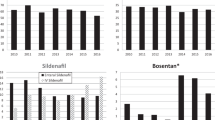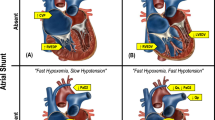Abstract
Introduction:
Infants and children with repaired congenital diaphragmatic hernia (CDH) often continue to show delayed growth and development that may be, in part, secondary to unrecognized persistence of increased pulmonary vascular resistance (PVR).
Methods:
Data were reviewed from all patients ages 6–36 mo with repaired CDH who underwent cardiac catheterization from 2007 to 2010 and were compared to data from a control population of patients undergoing percutaneous closure of a patent ductus arteriosus (PDA). Indexed pulmonary blood flow (Qp), mean pulmonary artery pressure (mPAP), pulmonary capillary wedge pressure (PCWP), and PVR were examined.
Results:
Data from 8 CDH patients and 10 control patients were examined. The mPAP (22.5 ± 3.33 vs. 18.2 ± 4.13 mm Hg) and PVR (3.66 ± 0.79 vs. 1.22 ± 0.4 iwU (indexed Wood’s units)) were both significantly elevated in the CDH population, whereas the Qp (4.08 ± 1.43 vs. 6.82 ± 1.46 l/min/m2) was significantly lower in this population. There was no significant difference in pulmonary capillary wedge pressure (PCWP). Less than half of the CDH patients had signs of pulmonary hypertension (PH) on echocardiogram.
Discussion:
Our data suggest that children who are ages 6–36 mo with repaired CDH have significantly increased PVR compared with controls and early consideration of cardiac catheterization may be warranted.
Similar content being viewed by others
Log in or create a free account to read this content
Gain free access to this article, as well as selected content from this journal and more on nature.com
or
References
Skarsgard ED, Harrison MR . Congenital diaphragmatic hernia: the surgeon’s perspective. Pediatr Rev 1999;20:e71–8.
Stege G, Fenton A, Jaffray B . Nihilism in the 1990s: the true mortality of congenital diaphragmatic hernia. Pediatrics 2003;112(3 Pt 1):532–5.
Clugston RD, Greer JJ . Diaphragm development and congenital diaphragmatic hernia. Semin Pediatr Surg 2007;16:94–100.
Bielinska M, Jay PY, Erlich JM, et al. Molecular genetics of congenital diaphragmatic defects. Ann Med 2007;39:261–74.
Gallot D, Marceau G, Coste K, et al. Congenital diaphragmatic hernia: a retinoid-signaling pathway disruption during lung development? Birth Defects Res Part A Clin Mol Teratol 2005;73:523–31.
Skari H, Bjornland K, Haugen G, Egeland T, Emblem R . Congenital diaphragmatic hernia: a meta-analysis of mortality factors. J Pediatr Surg 2000;35:1187–97.
Jaillard SM, Pierrat V, Dubois A, et al. Outcome at 2 years of infants with congenital diaphragmatic hernia: a population-based study. Ann Thorac Surg 2003;75:250–6.
Iocono JA, Cilley RE, Mauger DT, Krummel TM, Dillon PW . Postnatal pulmonary hypertension after repair of congenital diaphragmatic hernia: predicting risk and outcome. J Pediatr Surg 1999;34:349–53.
Kamata S, Usui N, Kamiyama M, et al. Long-term follow-up of patients with high-risk congenital diaphragmatic hernia. J Pediatr Surg 2005;40:1833–8.
Muratore CS, Kharasch V, Lund DP, et al. Pulmonary morbidity in 100 survivors of congenital diaphragmatic hernia monitored in a multidisciplinary clinic. J Pediatr Surg 2001;36:133–40.
Schwartz IP, Bernbaum JC, Rychik J, Grunstein M, D’Agostino J, Polin RA . Pulmonary hypertension in children following extracorporeal membrane oxygenation therapy and repair of congenital diaphragmatic hernia. J Perinatol 1999;19:220–6.
Yamataka T, Puri P . Pulmonary artery structural changes in pulmonary hypertension complicating congenital diaphragmatic hernia. J Pediatr Surg 1997;32:387–90.
Beals DA, Schloo BL, Vacanti JP, Reid LM, Wilson JM . Pulmonary growth and remodeling in infants with high-risk congenital diaphragmatic hernia. J Pediatr Surg 1992;27:997–1001; discussion 1001–2.
Shehata SM, Tibboel D, Sharma HS, Mooi WJ . Impaired structural remodelling of pulmonary arteries in newborns with congenital diaphragmatic hernia: a histological study of 29 cases. J Pathol 1999;189:112–8.
Kitagawa M, Hislop A, Boyden EA, Reid L . Lung hypoplasia in congenital diaphragmatic hernia. A quantitative study of airway, artery, and alveolar development. Br J Surg 1971;58:342–6.
Reid L . 1976 Edward B.D. Neuhauser lecture: the lung: growth and remodeling in health and disease. AJR Am J Roentgenol 1977;129:777–88.
Lally KP, Engle W; American Academy of Pediatrics Section on Surgery; American Academy of Pediatrics Committee on Fetus and Newborn. Postdischarge follow-up of infants with congenital diaphragmatic hernia. Pediatrics 2008;121:627–32.
Mourani PM, Sontag MK, Younoszai A, Ivy DD, Abman SH . Clinical utility of echocardiography for the diagnosis and management of pulmonary vascular disease in young children with chronic lung disease. Pediatrics 2008;121:317–25.
Author information
Authors and Affiliations
Corresponding author
Rights and permissions
About this article
Cite this article
Zussman, M., Bagby, M., Benson, D. et al. Pulmonary vascular resistance in repaired congenital diaphragmatic hernia vs. age-matched controls. Pediatr Res 71, 697–700 (2012). https://doi.org/10.1038/pr.2012.16
Received:
Accepted:
Published:
Issue date:
DOI: https://doi.org/10.1038/pr.2012.16
This article is cited by
-
Quantitative cardiopulmonary magnetic resonance imaging in neonatal congenital diaphragmatic hernia
Pediatric Radiology (2022)
-
Defining outcomes following congenital diaphragmatic hernia using standardised clinical assessment and management plan (SCAMP) methodology within the CDH EURO consortium
Pediatric Research (2018)
-
Increased contractility and impaired relaxation of the left pulmonary artery in a rabbit model of congenital diaphragmatic hernia
Pediatric Surgery International (2013)



